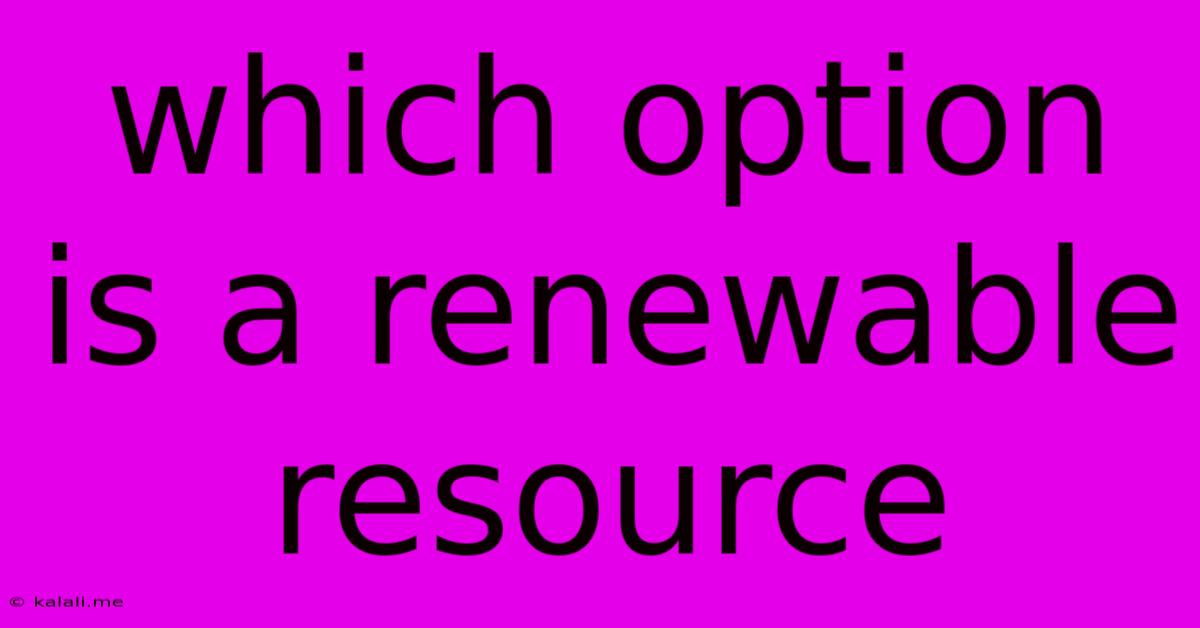Which Option Is A Renewable Resource
Kalali
Jun 14, 2025 · 3 min read

Table of Contents
Which Option is a Renewable Resource? Understanding Sustainable Energy Sources
This article will delve into the definition of renewable resources and explore several options, clarifying which are truly renewable and why. Understanding renewable resources is crucial in the fight against climate change and the transition to a sustainable future. We'll examine the characteristics that define a renewable resource and differentiate them from their finite counterparts.
What are Renewable Resources?
Renewable resources are naturally replenished at a rate that equals or exceeds their rate of consumption. This means they can be used repeatedly without depleting the supply. Unlike fossil fuels (coal, oil, and natural gas), which take millions of years to form, renewable resources are sustainable and environmentally friendly. They play a vital role in reducing our carbon footprint and mitigating the effects of global warming. Key characteristics include:
- Replenishable: They are naturally replenished over a relatively short period.
- Sustainable: Their use does not deplete the resource over time.
- Environmentally Friendly: They generally produce little to no greenhouse gas emissions during use.
Exploring Renewable Resource Options:
Let's examine several options and determine whether they fit the criteria of a renewable resource:
Solar Energy: A Leading Renewable Resource
Solar energy, harnessed through photovoltaic (PV) cells or concentrated solar power (CSP) plants, is undoubtedly a renewable resource. The sun's energy is virtually inexhaustible on human timescales. While the manufacturing process of solar panels has environmental impacts, the operational phase is clean and sustainable, making solar power a key component of a green energy future. This includes solar thermal technology for heating water and buildings.
Wind Energy: Harnessing the Power of the Wind
Wind energy, captured using wind turbines, is another excellent example of a renewable resource. Wind is a naturally occurring phenomenon driven by atmospheric pressure differences. While wind patterns can vary, the overall supply of wind energy is essentially unlimited. Offshore wind farms, in particular, are showing immense potential for large-scale clean energy generation.
Hydropower: Energy from Water
Hydropower, utilizing the energy of flowing water to generate electricity, is a significant renewable resource. However, the impact on river ecosystems and the creation of large reservoirs need careful consideration. While the water itself is renewable, the environmental consequences of dam construction need sustainable management strategies. Small-scale hydropower projects can offer a more environmentally friendly approach.
Geothermal Energy: Tapping into the Earth's Heat
Geothermal energy uses heat from the Earth's interior to generate electricity or provide direct heating. This resource is naturally replenished by the Earth's internal processes. It's a reliable and consistent source of energy, although geographically limited to areas with high geothermal activity.
Biomass Energy: Renewable with Caveats
Biomass energy, derived from organic matter like wood, crops, or waste, is considered renewable as long as it's managed sustainably. Unsustainable practices, such as deforestation or unsustainable agricultural methods, can negate its renewable nature. Proper forest management and the use of fast-growing biomass crops are crucial for its sustainability. Biofuels, derived from biomass, also fall under this category and face similar sustainability concerns.
Non-Renewable Resources: A Comparison
To fully understand what constitutes a renewable resource, let's look at some non-renewable resources:
- Fossil fuels (coal, oil, natural gas): These are finite resources formed over millions of years and their combustion contributes significantly to climate change.
- Nuclear energy: While nuclear power plants don't directly emit greenhouse gases, the limited supply of uranium and the challenges of nuclear waste disposal make it a non-renewable resource in practice.
Conclusion:
Solar, wind, hydropower, and geothermal energy are clear examples of renewable resources, offering sustainable and environmentally friendly alternatives to fossil fuels. Biomass energy holds potential but requires careful management for true sustainability. Understanding the differences between renewable and non-renewable resources is essential for creating a cleaner, greener future powered by sustainable energy.
Latest Posts
Latest Posts
-
Identify And Describe The Five Characteristics Of Adolescence
Jun 15, 2025
-
A Body Of Land Surrounded By Water On Three Sides
Jun 15, 2025
-
What Is The Lcm Of 3 And 16
Jun 15, 2025
-
Sat Scores For University Of Houston
Jun 15, 2025
-
Difference Between Express Contract And Implied Contract
Jun 15, 2025
Related Post
Thank you for visiting our website which covers about Which Option Is A Renewable Resource . We hope the information provided has been useful to you. Feel free to contact us if you have any questions or need further assistance. See you next time and don't miss to bookmark.